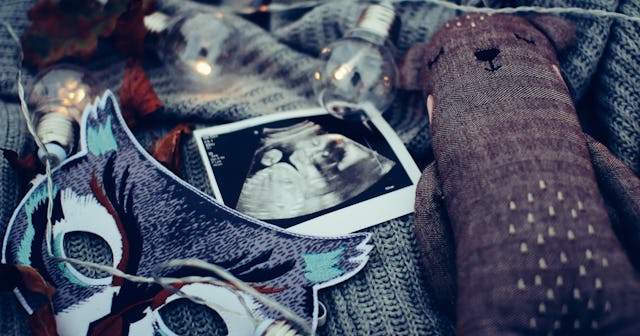What To Know About Placenta Accreta And How It Can Impact A Pregnancy

As much as we’d like to think that knowledge accumulated across generations coupled with advances in medicine means we have total control over pregnancy, anyone who has had the experience of being pregnant knows that’s not the case. Even if you do everything according to the books, and follow every suggestion from websites with expertise in the area (ahem), the truth is, there’s still a decent amount of what causes certain things to happen during a pregnancy that we haven’t entirely figured out yet. All this uncertainty and you haven’t even got to the newborn care part of the process.
None of this is meant to be scary (though it is a reminder that if something doesn’t go as anticipated during a pregnancy, absolutely, under no circumstance should you start questioning the pregnant person about what they possibly could have done differently to pinpoint what went awry — yes, even if you’re “trying to help”). Anyway, with all that in mind, if you’re here because you or someone you know is diagnosed with placenta accreta, you’d probably like to learn more about the symptoms during pregnancy, risks, treatment, and management of the condition. Here’s what to know.
RELATED: It’s Not Just You: Miscarriage And Ectopic Pregnancies Can Cause Long-Term PTSD
What are the symptoms of placenta accreta?
Placenta accreta occurs during pregnancy when the placenta attaches and then grows too deeply into the uterine wall. According to Brigham and Women’s Hospital, placenta accreta can lead to two significant complications: that the placenta can’t be delivered after the baby comes out (as usual), and that when doctors try to remove the placenta, it can result in heavy bleeding.
Typically, there are no signs or symptoms of placenta accreta during pregnancy. If someone does experience a symptom, it’s typically vaginal bleeding during the third trimester.
RELATED: Looking To Get Down? Here’s What You Need to Know About Sex After A Hysterectomy
What causes placenta accreta?
Although researchers haven’t yet pinpointed a single cause for placenta accreta, many of the people who develop the condition have abnormalities in the lining of their uterus. These are usually the result of scarring from a C-section or another type of uterine surgery. But according to the Mayo Clinic, not all patients who develop placenta accreta have uterine scarring, making it one of several possible risk factors, along with:
- Placenta position. If the placenta partially or totally covers the cervix (a condition known as placenta previa) or is otherwise situated lower down in the uterus, it could increase a person’s risk of placenta accreta.
- Maternal age. More common in women older than 35.
- Previous childbirth. The risk goes up with each pregnancy.
What are the different types of placenta accreta?
There are two other types of the placenta accreta condition, which are based on how deeply connected the placenta is to the uterus.
- Placenta increta. This is when the placenta is implanted in the uterus’ wall but doesn’t pass it. It is, however, connected to the uterus’ muscle.
- Placenta percreta. This is the most harmful condition because it’s when the placenta passes through the uterine wall. It grows through it, which can hurt the other organs.
How is placenta accreta diagnosed via ultrasound?
While placenta accreta is occasionally spotted during a routine pregnancy ultrasound, it’s more common to receive the diagnosis right before or during delivery. If placenta accreta is suspected while a person is still pregnant, it can usually be diagnosed via ultrasound, but in cases when it’s not detectable that way, magnetic resonance imaging (MRI) may be helpful.
According to Brigham and Women’s Hospital, placenta accreta can’t always be diagnosed before delivery. But at the same time, that won’t necessarily impact the outcome: some people who are diagnosed with placenta accreta before giving birth go on to have a routine delivery.
How is placenta accreta treated?
The treatment options for placenta accreta vary depending on when it was diagnosed and the severity of the case. More often than not, the treatment for placenta accreta is some type of surgery. In some situations, this means the surgical removal of either all or part of the placenta. There are a few ways to remove a placenta, which include cord traction and manual removal. Cord traction is when the placenta is massaged out of the uterus. This method is usually preferred because it causes less blood loss and results in shorter time in the hospital. However, manual removal means a doctor reaches inside of the uterus to remove the placenta from the uterus wall. They usually use up and down hand movements to help ease the placenta out.
When a diagnosis is made earlier on in the pregnancy, and the placenta accreta appears to be serious, the pregnant person and their healthcare team will discuss the options and may schedule a C-section delivery, followed by a hysterectomy (removal of the uterus). The combination of these two procedures can help prevent potentially life-threatening blood loss that can occur from separating the placenta from the uterus, according to the Mayo Clinic. If a hysterectomy is performed, the person’s ovaries are typically left intact to prevent them from going into premature menopause.
What happens if the placenta is left behind?
The placenta must be removed after delivery. When it is left inside the uterus, the uterus won’t close, which can cause hemorrhaging. The placenta should be delivered within 30 minutes of birth. If not, it can cause uterine scarring, need for a blood transfusion, or a hysterectomy. These complications can turn deadly if not treated right away.
This article was originally published on